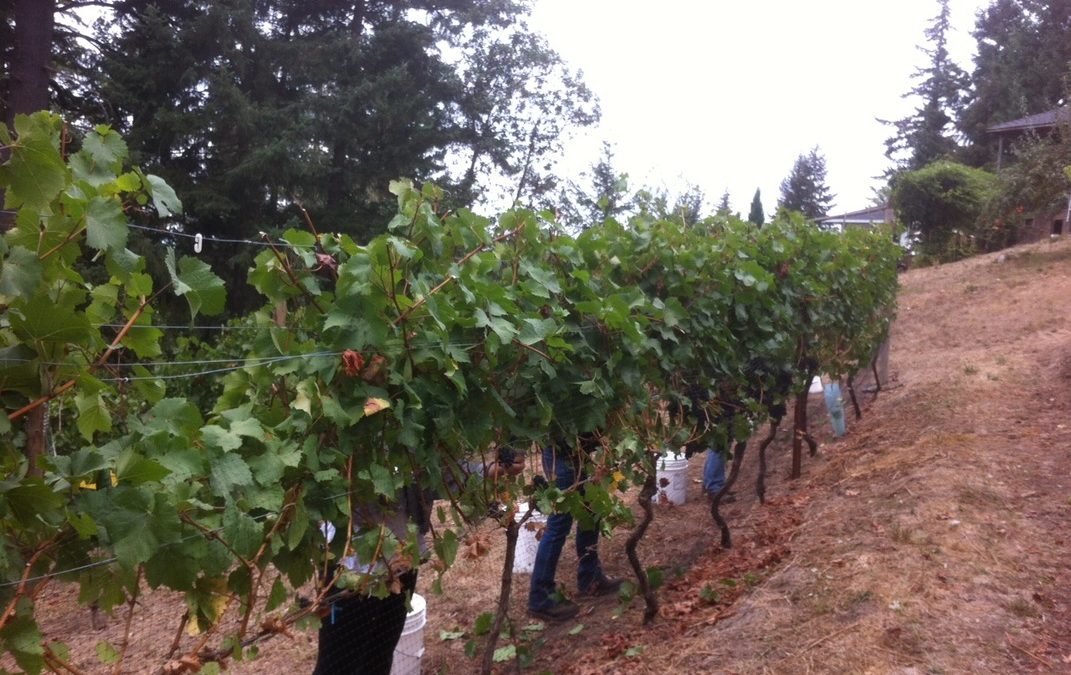Post By: Lydel Matthews
Photo: Noble Estate Vineyard
The month of August is coming to an end, and with September right around the corner, the question everyone wants to know is “When will harvest begin?” Ask any winemaker in the South Willamette Valley and they will tell you the 2015 harvest will be nearly a month early this year. I spoke with a couple industry locals to find out how preparations for this year’s vintage were going. Thanks to Alan Mitchell, the grower for Territorial Vineyards, and Jen Hilliard-Walsh, the wife of winemaker Ray Walsh who works for Capitello Wines and Territorial Vineyards, we’ve got an insider’s perspective on the 2015 harvest.
An early harvest generally means a hotter summer, but it doesn’t necessarily mean a shorter growing season. Alan points out that bud break was also a few weeks early and the vineyard still had a total of 170 days of growing time. He is expecting the 2015 vintage to produce more precocious wines, ones that generally take on “a more new world style, juicier, rounder, with higher alcohol and lower acid.” Essentially, the wines will be born ready and easy to drink.
While there certainly are many benefits to an early harvest such as picking grapes with fully developed flavor profiles and a lowered susceptibility to diseases such as botrytis, lest we forget the challenges a harvest crew must endure. Mitchell reminds me that “when veraison sets in, time pressure increases and the grapes start moving fast. You don’t want to let stuff get too ripe. You don’t want the grapes to ripen too fast in case you can’t get to it, you miss it, you make a mistake.” With the intense summer heat still lingering, you’ve also got to be wary of threats such as the grapes drying out, or in wine terms unsolicited “raisining”. Harvest is a pressing reminder that you are on the grapes’ time and not the other way around.
Capitello Wines has a vineyard in Marlborough, New Zealand, but they also source locally in South Willamette Valley. Their Rosé and Pinot Noir is made from grapes grown at Bennett Vineyards, the Sauvignon Blanc hails from Walnut Ridge Vineyard and the Pinot Gris from Territorial Vineyards. Jen expresses her concerns with this early harvest, “You’ve got to get all your ducks in a row earlier. There is a lot of preparation leading up – visiting vineyards and growers, testing brix levels, and making sure you have harvest crew and equipment in place.” Another issue both Alan and Jen brought to my attention was the undesirable necessity to sometimes dealcoholize wines, a costly reverse osmosis process that uses an expensive machine to remove a desired amount of alcohol from the wine. Alan explains that the excise tax is higher for wines over 15% alcohol and you can run into licensing compliance issues, and Jen reveals the nearest machine available to rent must be brought up from Napa Valley, California. As you can see, it’s easy to get lost in logistics of harvest, so let’s get back to the basics by focusing on the grapes.
In Alan’s words, he praises the Pinot Noir as “a big, hot, weird, bad, red wine. We’re in a marginal climate for ripening, they have to hang on and get little degree days. That hang time, the duration, that’s where you develop the complexity and character.” With the hot summer nearly behind us, many vineyards in this part of the valley and across the state are expecting higher grape yields. You’d think the more grapes the merrier, right? This isn’t always the case. Alan states, “I’ve spent a ton of money dropping grapes to get our yields down. It can be great for growers, but it’s not usually the best news because most of time you’ll have to spend money dropping fruit.” Jen expresses another concern related to higher grape yields, “This is a bumper crop year, the bulk market is going to be flooded…with so much amazing wine, prices are going to drop.” An overly productive vineyard has different outcomes for producers and consumers of wine.
When harvest begins, it’s all hands on deck. Alan enjoys the multi-generational experience of harvesting grapes and expresses “it’s cool to have that family part in play.” His father helps out every year by taking detailed notes of the process and his two boys also join in on the fun and hard work. For Jen however, harvest time means she’ll be a “wine widow” of sorts for six to eight weeks as Ray becomes consumed with testing, picking, crushing, pressing, and bottling the grapes. That being said, Jen is looking forward to digging up their bottle of Bourbon buried before their wedding at Walnut Ridge in an effort to thwart off the rains. Soon they’ll be toasting to a dual celebration of the 2015 harvest along with their wedding anniversary on September 6th!
